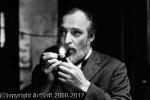Asger Jorn
Asger Jorn
Style: Tachisme;
Place: Vejrum
Born: 1914
Death: 1973
Biography:
Asger Oluf Jorn was a Danish painter, sculptor, ceramic artist, and author. He was a founding member of the avant-garde movement COBRA and the Situationist International. He was born in Vejrum, in the northwest corner of Jutland, Denmark, and baptized Asger Oluf Jørgensen.
The largest collection of Asger Jorn's works—including his major work Stalingrad—can be seen in the Museum Jorn, Silkeborg, Denmark.
He was the second oldest of six children, an elder brother to Jørgen Nash. Both of his parents were teachers. His father, Lars Peter Jørgensen, a fundamentalist Christian, died in a car crash when Asger was 12 years old. His mother, Maren, née Nielsen, was more liberal but nevertheless a deeply committed Christian. This early heavy Christian influence had a negative effect on Asger who began progressively to inwardly rebel against it, and more generally against other forms of authority.
In 1929, aged 15, he was diagnosed with tuberculosis, although he made a recovery from it after spending three months on the west coast of Jutland. By the age of 16 he was influenced by N. F. S. Grundtvig, and although he had already started to paint, Asger enrolled in the Vinthers Seminarium, a teacher-training college in Silkeborg where he paid particular attention to a course in 19th century Scandinavian thought. Also at about this time Jorn became the subject of a number of oil paintings by the painter Martin Kaalund-Jørgensen, which encouraged Jorn to try his hand in this medium.
When he graduated from college in 1935, the principal wrote a reference for him which said that he had attained 'an extraordinary rich personal development and maturity' – especially because of his wide reading in areas outside the topics required for his studies. While at college he joined the small Silkeborg branch of the Communist Party of Denmark and came under the direct influence of the syndicalist Christian Christensen, with whom he became close friends and who, Jorn was later to write, was to become a second father to him.
In 1936 he traveled (on a BSA motorbike he had scraped together enough money to buy) to Paris to become a student of Kandinsky. However, when he discovered that Kandinsky was having economic difficulties, barely able to sell his own paintings, Jorn decided to join Fernand Léger's Académie Contemporaine; it was during this period that he turned away from figurative painting and to abstract art. In 1937 he joined Le Corbusier in working on the Pavillon des Temps Nouveaux at the 1937 Paris Exhibition. He returned again to Denmark in the summer of 1937. He again traveled to Paris in the summer of 1938, before returning to Denmark, traveling to Løkken, Silkeborg and Copenhagen. Asger Jorn was a good friend of the Danish art dealer Børge Birch, owner of Galerie Birch, who sold his art as early as the 1930s. Later on Jorn held many group exhibitions and solo exhibitions in different galleries.
From 1937 to 1942, he studied at the Royal Danish Academy of Fine Arts in Copenhagen.
The occupation of Denmark by Nazi Germany was a time of deep crisis for Jorn, who had been deeply inculcated with pacifism, initially sinking him into deep depression. He subsequently became active in the communist resistance movement. During the war he also co-founded with the architect Robert Dahlmann Olsen the underground art group, Helhesten or "hell-horse," and was a contributor to its journal. In 1939, he wrote the key theoretical essay, "Intimate Banalities," published in Helhesten, which claimed that the future of art was kitsch and praised amateur landscape paintings as "the best art today." He was also the first person to translate Franz Kafka into Danish.
After the war, he complained that opportunities for critical thinking within the context of the communist arena had been curtailed by what he characterised as a centralised bourgeois political control. Finding this unacceptable, he broke with the Communist Party of Denmark, although he did not hand in his membership until the mid-1960s and remained committed philosophically to a revision of the Marxist analysis of capitalism from the point of view of the artist.
He traveled again to France where he, together with Christian Dotremont and Constant, founded COBRA (a European avant-garde art movement), and edited monographs of the Bibliothèque Cobra.
He returned, impoverished and seriously ill with tuberculosis, to Silkeborg in 1951 and resumed work in the ceramics field in 1953. The following year he traveled to Albissola Marina in Italy where he became involved with an offshoot of COBRA, the International Movement for an Imaginist Bauhaus.
In 1954 he met Guy Debord, who was to become a close friend. The two men collaborated on two artist's books, Fin de Copenhagen (1957) and Mémoires (1959), along with prints, and forewords to each other's work.
He participated in the conference that led to the merger of the International Movement for an Imaginist Bauhaus, the Lettriste Internationale, and London Psychogeographical Association to form the Situationist International in 1957. Here he applied his scientific and mathematical knowledge drawn from Henri Poincaré and Niels Bohr to develop his situlogical technique. Jorn never believed in a conception of the Situationist ideas as exclusively artistic and separated from political involvement. He was at the root and at the core of the Situationist International project, fully sharing the revolutionary intentions with Debord. The Situationist general principles were an attack on the capitalist exploitation and degradation of the life of people, and solution of alternative life experiences, construction of situations, unitary urbanism, psychogeography, with the union of play, freedom and critical thinking. Such general principles were applied by Jorn to painting.
More...
Wikipedia link: Click Here


